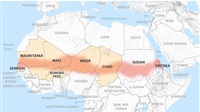Al-Qaeda moves to build network in North Africa

Al-Qaeda has recently been trying to ferociously expand its
presence in African countries, imposing a number of alleged states that work
for the terrorist organization’s leaders, who are sheltering in the mountains
of Afghanistan.
In their book "Al Qaeda: The Transformation of
Terrorism in the Middle East and North Africa", Denise N. Baken, a
lecturer at George Mason University who specializes in African affairs, and Ioannis
Mantzikos, a Saharan affairs researcher at the same university, examine the
possible future factors and consequences of this parallel expansion similar to
that in the Arabian Peninsula, particularly in Yemen.
The book attempts to answer some questions about the
relationships within al-Qaeda and how it managed to build a base in Africa
bypassing the war launched by the United States in Afghanistan. It also looks
at how the organization’s main leadership and its followers in different parts
of the world communicate with each other and the role of various means of
communication and technological developments in this direction, along with the
measures that the international community must take to repel this expansion as
quickly as possible. What are the material and humanitarian costs that the
world may incur in this war?
Communication technology
The researchers at George Mason University focus on the
technological revolution in the world of communication and al-Qaeda’s
adaptation to its development to increase the organization’s spread and
communication among its elements in different areas, facilitating the transfer
of orders and movements. This clearly shows evidence of expansion, operations,
attainment of arms, and geographically narrow economic operations, but it is
wide-ranging, such as the Somali coal mined by al-Shabaab, while its physical
impact reaches Iran and the movement's leaders in Afghanistan.
The book refers to the power of recruitment and the
inclusion of elements in the ranks of the organization more broadly through its
advanced communications network that enables the organization to prepare
material to incite elements to belong to the organization, as well as to
promote al-Qaeda’s strength and spread, which brings it more elements and funds
for operations that favor major powers who benefit from the terrorist presence.
Doctrine and expansion
"Al Qaeda: The Transformation of Terrorism in the
Middle East and North Africa" mainly focuses on the factor of faith as a
main pillar in the inclusion of elements in extremist organizations, but the
broader expansion and influence remain linked to those inspired by ideas, most
notably from the viewpoint of Brotherhood theorist Sayyid Qutb and Abu al-Ala
al-Maududi, who developed the idea of global terrorism.
Through the books of Sayyid Qutb and his ideas about
establishing Islamist organizations around the world as the most appropriate
doctrine for leading “ignorant societies”, terrorist elements derived the
necessity and justification for expanding their positions to more than one
place, which the organization’s leaders rely on to persuade followers to build
new strongholds. According to the researchers, this terrorist doctrine,
al-Qaeda’s adaptation to technological developments in communications and
information technology, and security being overlooked by some major
international powers with the same ambitions in the region are all major
factors contributing to al-Qaeda’s expansion in North Africa, regardless of the
war in Afghanistan.







